Care
Conditions of detention
- When growing a plant in a garden area, you need to choose a bright place that would be shaded during the day.
- The rose does not tolerate direct sunlight on leaves and flowers.
- The site should not be in a swampy area and be heavily blown.
Reference. Since floribunda is a winter-hardy plant, it tolerates harsh climatic conditions well.
Watering
- Abundant watering is recommended during the growth period of the bush, with it the frequency of the procedure is up to 2 times a week.
- Rare watering is required for floribunda bushes in the fall - at this time, the plant is irrigated no more than once every 2 weeks.
- In winter, in Central Russia, watering rose bushes in the open field stops, since there is no need for it during this period.
Floribunda is a moisture-loving plant, but excessive moisture and stagnation of liquid in the soil should be avoided.
Pruning
A must for normal plant growth.
- In the spring, all frozen and damaged shoots are pruned and the crown of the bush is formed.
- Sanitary pruning is performed at the end of autumn.
Garter
Reference. Floribunda bush with normal development does not require additional support and garter.
If the bush is formed in an undesirable way or tilts to the ground, a peg is driven into the soil and the bush is tied with a rope to the support.
Transfer
A rose bush is transplanted in several cases:
- during the initial planting of a seedling;
- if necessary, in the rejuvenation of the old bush;
- if the floribunda does not take root in the selected area.
When transplanting, it is important not to damage the roots of the bush when digging up, otherwise it is necessary to follow the general rules for planting a plant
Preparing for winter
- Autumn is a crucial time for a grower: to prepare floribunda bushes for winter "hibernation", roses are cut to the size of a shelter.
- Further, the floribunda bushes are spud and fed with organic fertilizers, which is necessary for the most comfortable wintering.
- Finally, rose bushes are covered with peat, covered with spruce branches and on top of it - with a durable non-woven material.
More details about growing and caring for Floribunda are described here.
Features of the floribunda group
Floribunda became the second sensational and beloved by millions of summer residents species of roses. It appeared as a result of crossing polyanthus, tea-hybrid and musky varieties. Its clear advantage is its abundant flowering. Not very large buds, consisting of 3-8 pieces, create a gorgeous inflorescence, which attracts their fans.
The obvious differences between the floribunda variety:
- long flowering - from early summer to late autumn;
- a wide variety of shapes, shades and terry;
- abundant flowering, up to 9 pcs. on one stem;
- not whimsical;
- cannot be pruned in the fall.
Flower growers like it precisely for their characteristics and the fact that different varieties differ from each other in appearance. That is, the product range of the floribunda group is very wide.
Varieties of hybrid tea roses
During the selection process, many varieties of roses were bred. However, it is worth highlighting several unusual varieties that differ in their unique characteristics.
Table 1. Common varieties of roses
| Name | Description |
|---|---|
|
"Black magic" |
This is the name of the rose received because of its color. The petals in a closed bud are almost black in color. Only when it dissolves does the rose acquire a scarlet color. The diameter of the opened bud is 11-12 centimeters. This variety is used both for group plantings for landscape decoration and for cutting. |
|
"Black Baccarat" |
The leaves of this rose have a deep red, almost black color.The buds are medium, when fully opened they reach 9-10 centimeters in diameter. Such a variety is planted mainly in the shade - it is there that the beauty of the rose is manifested as much as possible. |
|
Gloria Day |
The history of the spread of roses has been impressing gardening enthusiasts for more than a dozen years. Because the variety was brought to America on the eve of the capture of France by the German Nazis. After that, the rose was presented to the general public in 1945 and given the name Peace, which means peace. But, the main feature of the variety is that the rose changes color at different stages of dissolution. At first, you can see the yellow petals with a crimson frame, which later turn creamy with pink splashes. |
|
"Ballerina" |
Upright rose, belongs to the category of semi-double varieties. The buds are large, the petals are cherry-colored. The variety is prone to various fungal diseases. |
|
"Alexander" |
The variety of this rose has erect stems, which reach a height of up to 150 centimeters. The petals are deep red, when fully opened, the diameter of the bud is about 11 centimeters. Roses are planted in flower beds, personal plots, and also grown for cutting. |
|
"Dame de Kerr" |
Cold-resistant variety, which is extremely rarely exposed to any fungal diseases. The bush grows up to 90 centimeters in height. The bud is elongated, up to 11 centimeters in diameter, carved petals, bright crimson color. |
Such roses are hybrids from other progenitors. The need for crossing arose because the noble varieties of roses began to lose their basic qualities. After the creation of hybrids of various shades, a significant number of unique varieties have been added.
Varieties of white roses: a brief description
Mention should be made of the most popular varieties of rose bushes (each name and characteristics):
White Meidiland rose
The rose was bred in France. Can be used as a ground cover for decorating lawns, flower beds, etc. Double flowers reach 8.5 cm in diameter, consist of 65-70 petals. The plant is bushy, spreading. The branches are light yellow with large dark green leaves. The advantages of this variety are high resistance to severe frosts, good tolerance of hot and rainy weather conditions. Rose White Meidiland is highly resistant to diseases of fungal etiology.
White Meidiland rose
Rose White o Hara
This variety of white rose belongs to the peony varieties of the hybrid tea group. The snow-white shade of the petals takes on a creamy shade closer to the core. The bud diameter is up to 12 cm, its height varies from 6 to 7 cm. Rose o Hara is suitable for growing in a greenhouse or "winter garden". For good plant growth, a warm microclimate is needed in combination with bright shrub lighting. The supplier is Ecuador.
Rose White Morsdag
It has a spherical shape of the bud, which makes it original. The petals are milky white. The flowers are small in size, they are of the semi-double type. On a branch, the buds are collected in inflorescences. Rose White Mosdag is bushy, its height is normally from 40 to 49 cm, and its width is 65-70 cm. White Morsdag roses have glossy, dark green foliage, which is harmoniously combined with the color of the petals.
Rose White Chocolate
It is a snow-white variety of flowers. The shade can be called "sugar" interspersed with the color of white chocolate at the core of the buds. The chic large flower has become the key to the popularity of the variety around the world. It is one of the representatives of the hybrid tea group of roses. High resistance to low temperatures. The cultivar is highly resistant to diseases such as powdery mildew and black spot, common among rose bushes.
Rose White Sunrise
It belongs to the climbing group of pink plants. The height of the lashes ranges from 2 to 3 m. The buds are large-sized (up to 13 cm) and consist of double-type petals. The plant survives high temperatures, rainy weather, and frost well.High resistance to diseases (powdery mildew, black spot).
Rose White Cloud
A climbing rose, the height can be 1.7-2.4 m. The diameter of the bud after opening reaches 8 cm. The petals of the flower are white in color with a cream shade.
Rose White Knight
Large flowering bush. The bud consists of snow-white petals, the edge of which is outlined by a barely noticeable light green border. Flowers look good in bouquets.
Rose White Licorice
The buds are large, classical in shape. The flower has a rich scent with hints of citrus. The foliage is dark green, semi-clayey. Plants resist disease well. The height of the bush can be either 80 or 120 cm.
Rose White Licorice
Rose White Bubbles
Shrub rose. On average, one bush gives 3 to 7 shoots with buds. The minimum diameter of the flower is 6.9 cm, the maximum is 8 cm. The bud is formed from 45-50 petals.
Rose White Dragon
Belongs to the class of hybrid tea roses. The height of the bush reaches 65-79 cm, its width, depending on the conditions, can be either 30 cm or 40 cm. The foliage is saturated green, matte in appearance. By its size, the bowl of the bud is 9 cm in diameter and consists of 45-47 wavy petals. In terms of frost resistance, the variety is characterized by average indicators, while the resistance to diseases is high.
Rose White Lie
It is a representative of spray roses. In height the bushes reach 0.8-1 m. The branches are "strewn" with small double buds.
These varieties of white roses are especially popular with flower growers for their unique color, as well as resistance to bad weather and disease.
From each group of roses, you can choose varieties with snow-white buds. This means that lovers of white roses can decorate with these flowers not only a flower bed, but also decorate a gazebo, a fence or a wall of a building.
vote
Article Rating
Floribunda roses - care and cultivation
Care is not complicated: loosen the soil in time, remove weeds, do not forget to mulch. The main focus of floribunda care is pruning. To the above information, it should be added that spring pruning is the main, formative and sanitary. Summer pruning aims to increase the flowering time of the rose. But in the fall, this process should not be carried out so as not to weaken the plant before the coming winter.
Keep in mind that weak and poorly growing floribundas should be pruned more actively and stronger than powerful and strong representatives - this process activates the vitality of the rose, provokes the growth of new and renewal of old shoots. If you cut the bush very strongly in the spring, then flowering may come late, with the arrival of August or even September (in some varieties).
Floribunda rose loves abundant watering, with the arrival of summer heat, at least 10 liters of water must be poured under each bush. You need to do this once a week, but with the arrival of extreme heat, you can do it twice. The best time to water roses is early morning or evening, you should not do this on a sunny day
It is especially important to saturate the plant with moisture during bud and foliage blooming, as well as after the first flowers appear.
With the onset of autumn, watering becomes less frequent, especially when it rains.
As for fertilizers, during the active growth phase, it will not be superfluous to feed the plant with a nitrogen supplement or mullein (1 or better 2 times). By the end of summer, floribunda can be fertilized with a potassium-phosphorus supplement (for example, potassium nitrate, potassium sulfate, ammophos, superphosphate). Top dressing is applied as follows: grooves are formed around the bushes, they are poured with water, after the water is absorbed into the ground, it is the turn of liquid fertilizers, after which everything is again filled with water, covered with soil. Keep in mind that in the first year after planting, the bush is not fertilized with anything.
To prevent the appearance of fungi, until the buds on the rose bloom, it should be sprayed with Bordeaux liquid or a solution of copper sulfate.
Insecticides such as "Actellik", "Karbofos", "Rogor" will help from the invasion of pests.
For the winter, the rose must be covered, and before sheltering, cut off all the buds, remove the foliage and unripe shoots (they are red, not green). After that, the shrub is treated with Bordeaux liquid, and all the removed plant fragments are collected and burned.
When trimmed, the floribunda bush should be about 30-40 cm in height.
For the winter, they huddle it up and cover it with peat or river sand, so that the plant is completely covered. For reliability, especially if the winter promises to be cold, you can additionally cover it on top with spruce branches. Alternatively, you can cover the bush with some special material (for example, lutrasil), and then additionally spud it with sand and cover it with pine or spruce branches.
Flower Trimming Instructions
Correct pruning stimulates the formation of strong basal shoots and forms a globular crown with evenly distributed stems. In seedlings, before planting, the stems are slightly shortened and damaged, diseased and too long roots are cut off.
Basic rules for pruning:
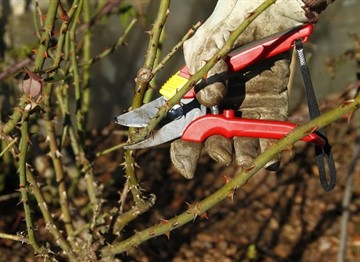
- in the first spring after planting, they perform strong pruning of the stems - up to 2 - 4 buds (about 15 cm in length), in tall varieties - up to 8 (about 30 cm in length). This is done when the kidneys reach a length of 0.5-0.8 cm;
- in the summer after flowering, wilted buds with a small part of the stem should be cut off - then the bush does not form fruits and will bloom again;
- in the fall, flowering shoots are slightly shortened and non-flowering, non-lignified and damaged shoots are cut out. Radical pruning is unacceptable, otherwise the bush runs the risk of freezing in winter;
- in the second year, in the spring, remove diseased, damaged and frozen shoots, as well as weak, crisscrossing and growing inside the bush. Strong stems shorten up to 4-6 buds (20 cm), lateral ones - up to 3 - 4 buds;
- autumn pruning is performed in the same way as in the 1st year.
It is better to burn the removed shoots - they may contain pathogens or harmful insects.
Features of floribunda roses
The name of this group of varieties of roses is translated as "abundant flowering". Any roses in this category have abundant, long-lasting, almost continuous flowering. Floribunda is the result of crossing tea and polyanthus roses at the end of the 19th century. Bushes vary in height: from curbs (about 40 centimeters) to plants over 1 meter high. Flowers come in different shapes. The variety of colors is also wide.
Floribunda roses are also planted in spring and autumn. Water should only be done with warm water. After irrigation, you must immediately loosen the soil. Plants require the introduction of nitrogen fertilizers during the flowering period, and in the fall, after the withering of the flowers, phosphorus-potassium fertilizers. You can propagate these gorgeous flowers by seeds, cuttings, dropping.
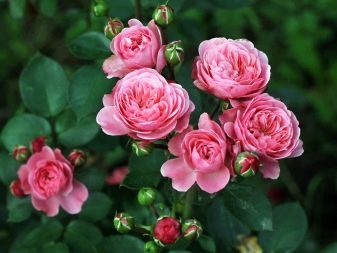

Landing
Best planted in spring, April-May. Floribunda rose is a light-loving plant, therefore it should be planted in places where there is a lot of sun, with an orientation to the south - southeast, southwest. A standard hole is dug, approximately 40 cm in diameter and 40 cm deep. The dug hole is abundantly filled with water. Further, about half of a garden bucket of high-quality fertile soil is poured into the pit. The roots of the plant should be omitted in the so-called. "Talker" - a mixture of clay and mullein.
It is believed that in this way the plant takes root better. After that, the plant is placed in the center of the previously prepared planting site and sprinkled with the remains of the earth (fertile mixture). Next, the floribunda rose should be thoroughly shed with water. Mandatory mulching.
Use of Polyantha-Rose in summer cottages
These are versatile roses that are good in single and group plantings, in flower beds - among perennials and annuals.
Polyanthus rose 'The Fairy' variety in mixborders. Photos from the websites Alamy and foto.mein-schoener-garten.de
The possibility of good grafting and obtaining a large number of self-rooted roses of "the same standard" make them convenient for arranging borders (undersized), hedges, flower arrays, and use as ground cover shrubs.
Polyanthus rose ‘The Fairy’ solitaire, photo from Pinterest and in ordinary planting by the fence, photo from Landscape-Project
Low-growing varieties are ideal for potted indoor crops and patios.
Polyanthus rose 'Yvonne Rabier' variety in a tall pot, photo from Mon jardin de roses anciennes
Some Polyantha-Rose (for example ‘The Fairy’) are used in the standard culture, and even in rocky gardens, polyantha roses look harmonious.
Polyanthus rose cultivar 'The Fairy' in rockery, photo via Flickr
So, we meet 10 polyanthus beauties, who seem to be covered with a veil, behind which lies a secret, often associated with a woman.
Names of the best varieties with description
These varieties are most popular among gardeners.
Black magic
A very beautiful culture with goblet flowers up to 10 cm in diameter and bright green glossy leaves. The height of the bush is 100 cm.
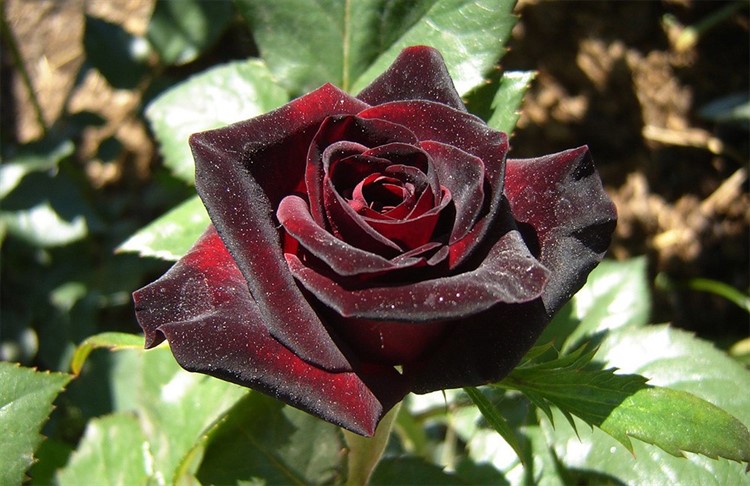
Black magic
The variety was bred for cutting, therefore it stands in water for a long time - up to 2 weeks. Resistant to heat, cold, disease, tolerates rainy weather well, without losing its attractiveness.
Gloria Day
Tall bushes (up to 1.2 m) with large flowers up to 15 cm in diameter. The foliage is dark green, shiny. The flowers are bright yellow with a pinkish border.
Double Delight
Like Black Magic, this strain has won numerous prizes. The main differences are a strong fruity aroma and multi-colored petals: creamy in the center, bright crimson along the edge. Dissolving, the flower changes color, increasing the proportion of crimson. The diameter reaches 15 cm.
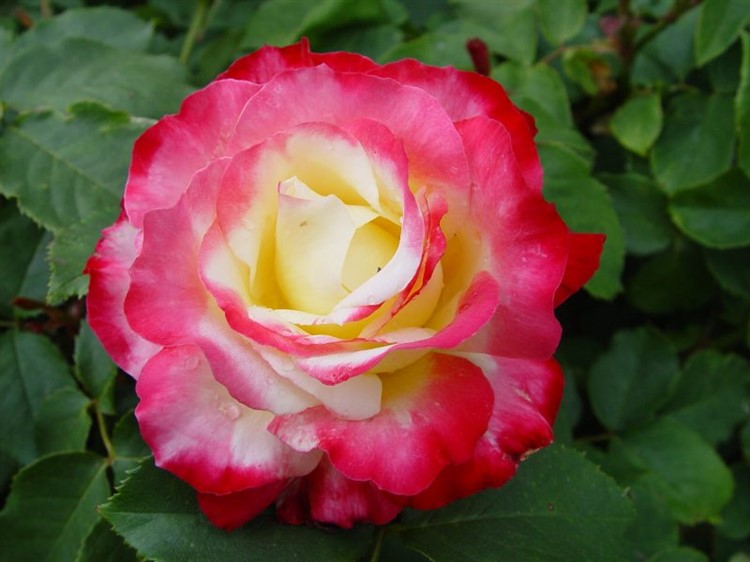
Double Delight
Black Baccarat
A small neat plant 80 cm high and 70 cm wide. The flowers are goblet-shaped with almost black petals, the leaves are slightly reddish. There are about 45 petals in a bud, with wavy pointed edges. Flowers reach 10 cm in diameter.
Doris Thisterman
Large bushes up to 150 cm high and up to 100 cm wide. The diameter of the flower is 8-9 cm. The petals are orange, reminiscent of an apricot or tangerine. An interesting effect is achieved due to the difference in shades: on the one hand, the petals are darker, on the other - lighter.
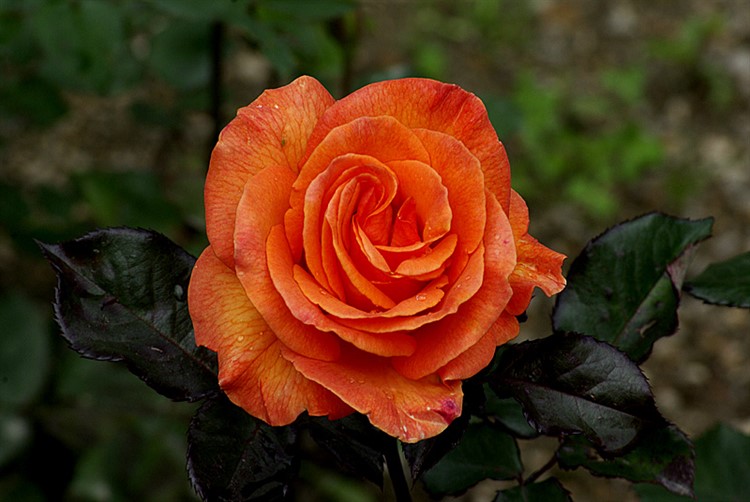
Doris Thisterman
The outer petals are larger than the inner ones, due to which the flower looks very attractive. The shoots are decorated with dark shiny leaves and large thorns.
Blue Nile
A spectacular flower that changes color as it unfolds. This ability often deceives newcomers into thinking they have acquired the wrong variety. The bushes are large, can reach 1.5 m in height and 1 m in width.
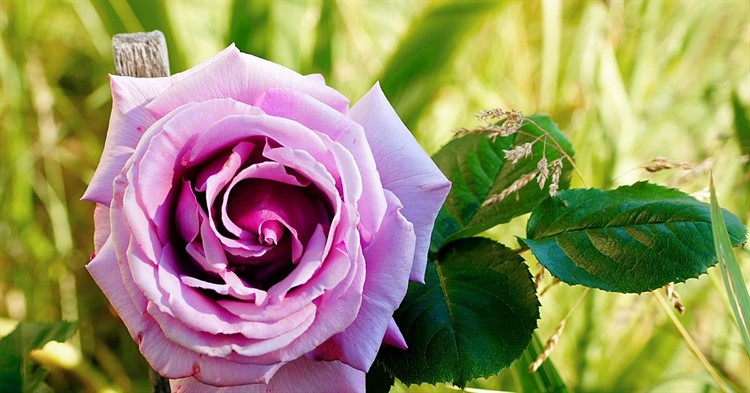
Blue Nile
The flowers are also large - up to 12 cm in diameter. They give off a pleasant, strong aroma. The plant blooms throughout the season, tolerates frosts down to -23C.
Green tea
Variety with green buds. In addition to color, the unusual appearance is due to the large number of petals. The bushes are small - up to 70 cm in height, while the flowers have a diameter of up to 8 cm. After cutting, they stand in water for up to 2 weeks. Green Tea roses emit a strong fragrance and bloom throughout the season.
General information about floribunda roses
This group of roses has gained immense popularity due to its abundant, almost continuous flowering. They are fully consistent with their name, because floribunda literally translated from Latin means "abundantly flowering".
Floribunda roses and their characteristics
The floribunda group includes many varieties, its flowers occupy an intermediate position between hybrid tea roses and polyanthus roses.
By height, the bushes are divided into three subgroups:
- low (curb) - bushes reach a height of about 40 cm;
- medium height - from 0.6 m to 0.8 m;
- high - from 100 cm and above.
Perhaps no other group has such a variety of colors, and clearly surpasses other groups in brightness.Flowers of floribunda roses are simple, double, semi-double with cupped, flat, goblet glasses, collected in multi-flowered or few-flowered inflorescences. Their usual size ranges from 4 to 9 cm.
Most varieties bloom continuously or in three waves. Bright flowers open in carpal inflorescences several at a time, and most varieties of floribunda roses bloom either continuously or have three waves of flowering.
It should be added that these flowers have excellent winter hardiness, resistance to rain and diseases, moreover, for the most part, they can reproduce by cuttings.
In different countries you can find different names of flowers of this group, they are even called simply "bouquet roses" or "bush roses with inflorescences." They are widely used to decorate private gardens, parks, landscaping areas near large office buildings. They are planted in large pots, and the best floribunda roses are used as cut flowers.
The history of floribunda roses
At the beginning of the last century, the family of Danish breeders Poulsen crossed polyanthus roses and hybrid tea, as a result of which in 1924 the first hybrid-polyanthine variety "Else Poulsen" appeared. From the polyanthus, this flower took the carpal inflorescences and good health, and from the hybrid teas - the graceful shape and large size of the glass.
Elsie Poulsen
Later, with repeated multiple crosses of hybrid-polyanthus roses with hybrid tea and other garden varieties, breeders in Denmark, Germany, Great Britain and the United States obtained many varieties that needed to be combined into a separate group. So, in 1952, a group of floribunda roses appeared, which included hybrid-polyanthus varieties.
Although the floribunda group has existed not so long ago, a group of patio roses has already been isolated from it, which includes many, but not all, low-growing varieties with a height of about 50 cm. Varieties with creeping or drooping shoots are allocated to the group of ground cover roses. Plants with small flowers and long, up to 2.5 m shoots have moved to the group of climbing roses. Recently, we increasingly hear the name "grandiflora" - this is how floribunda roses are called today, which have especially large flowers. This group has not yet been officially recognized, but the history of roses continues, who knows what changes await us tomorrow.
Which roses are better than hybrid tea or floribunda
Everyone will answer this question differently. Floribunda roses are undoubtedly inferior to hybrid tea varieties in elegance and bud size, most of them do not have their magical aroma. But they do not bloom in waves, but almost continuously until frost, the beauty of the glass is compensated by the abundance of buds, sometimes completely covering the bush, and even if they are not so exquisite in the floribunda, they are collected in huge brushes, sometimes consisting of dozens of buds.
Most hybrid tea varieties of roses are capricious, require careful care, which determines the quality of the flower, and sometimes even the intensity of the aroma. Almost all varieties do not go beyond the sixth climatic zone; for the northern regions, their choice is very limited. Resistance to typical diseases of roses leaves much to be desired, not to mention the vulnerability of buds to getting wet.
Floribunda is easier to care for, it rarely gets sick, the buds can withstand rainy weather. And most importantly, these roses are frost-hardy, which means that they winter well with proper shelter.
If you live in the southern regions and a qualified gardener does all the work for the owners, then it is the hybrid tea rose that is the best solution for your site. But for people living in an unfriendly cold climate and who want not to bend their backs in flower beds, but to enjoy the beauty of flowers in their rare free moments, floribunda roses will become reliable companions.
Believe me, both groups of roses are beautiful, each has its own special charm.The choice of varieties for the site requires an approach to the issue not only from an aesthetic, but also from a purely practical point of view.
Step by step care instructions
Conditions of detention
When growing hybrid tea roses, the following conditions must be observed:
- Temperature. It should be mild in summer and cool in winter. The optimal temperature regime remains 20-25 degrees Celsius. But small daily fluctuations for the plant will only be beneficial.
- Lighting. Hybrid tea roses love warmth and sun. They do not tolerate drafts well. They need to be grown in a well-lit place, protected from northern winds.
- Humidity. The rose does not have any special requirements for humidity. It is undesirable to spray the bush with water in the summer, as the buds can wilt, and the leaves can get burned.
Watering
Regular moistening of the rose is important in the summer during flowering. Drying out of the earth during this period is dangerous, so you need to water immediately after the soil dries out.
For these purposes, settled and filtered water is used.
Top dressing
In spring and summer, fertilization should be applied every 2 weeks, alternating between mineral and organic nutrients. You need to use standard fertilizers designed for roses.
Pruning
If the pruning is done in a timely manner, the bush will look neat and the bud formation will be early and lush.
Procedure for pruning:
- Disinfect scissors or a knife with alcohol.
- Remove all yellowed, dried leaves and wilted flowers. Cut flowers to the first leaf.
- Before the winter rest, the stems are pruned, which must be shortened by 10 cm. There should be 4-5 buds on each branch.
- Treat the cut sites with activated carbon powder.
We suggest watching a video on how to properly prune a hybrid tea rose:
Transfer
It is carried out in early spring in compliance with the following recommendations:
- Water the plant well the day before transplanting.
- Dig a recess so that the roots fit into it and do not bend - 50-60 cm.
- Fill the hole ½ part with a mixture of sand, organic matter and garden soil in equal proportions.
- Pour 2 liters of water over the dry soil.
- Lower the seedling into the hole, spread the horses and fill all the voids with the nutrient mixture. At the end, tamp the earth and water it.
Bloom
The hybrid tea rose blooms in mid-June to late autumn. At this time, the bushes are covered with the following flowers:
- yellow;
- pink;
- white;
- purple;
- orange;
- red.
The lack of flowering can occur for various reasons, but there are a number of points, subject to which the plant will bloom profusely and for a long time:
- Choose a quality seedling.
- Provide lighting for the plant.
- Choose the right soil: light, air- and moisture-absorbing with a neutral pH.
- Do not plant in northern or windy areas.
- Insulate the bush in winter qualitatively.
Variety of hybrid tea rose "Double pleasure"
Among the numerous varieties of the queen of flowers, the bright beauty of the Double Delight rose stands out. In translation, the name of the flower means "double pleasure". Florists cannot give an exact answer to what this means: double coloration or compatibility of color and smell. Only with admiration they speak of the striking unusual beauty of the plant. As proof of the veracity of these words, we present a photo of a hybrid tea representative of the flora.
Brief description of the variety
The popularity of the presented plant is due to the bright color of the flowers. At the beginning of flowering, they have a pale creamy shade, but as they bloom, they acquire a rich reddish-crimson edging of the petals. The scent of rose flowers is simply amazing, with fruity notes. It is characterized by duration and depth.
A two-color specimen has 1 large bud, sometimes their number can reach 3 pieces on one shoot.The tea hybrid has green, dark foliage, strong long spiny stems. Branched bush, erect, up to 1 meter high.
Flowers reach 13 cm in diameter. Due to the presence of numerous petals, they seem double. The beautiful owner of two-tone flowers has an ideal bud shape.
Attention! The plant is not capricious, it can be grown even in Siberia. However, you need to follow the recommendations of specialists for the cultivation and care of an unpretentious beauty.
The type of tea hybrid presented is suitable for both single and floristic compositions. The rose looks good in cut, gorgeous in bouquets.
Growing conditions
The hybrid type of plant is quite simple to grow and breed. However, greenhouse conditions for this type are unfavorable. The fact is that the "Double Delight" rose is very fond of ultraviolet light, i.e. sun rays of light. In greenhouses, it is not enough and the petals remain cream-colored without a cherry border.
Attention! On the street, in the open air, there is another reason for the poor-quality rose bloom. In the rain, the flowers acquire reddish spots
There is also a high probability of the appearance of powdery or spotty dew.
A wonderful condition for breeding a hybrid tea species is frost resistance. In other words, this type of flora is easily grown in the Siberian climate.
However, for the winter, you should carefully cover the plant to avoid freezing.
Breeding varietal roses
Considering that the Double Delight rose is sensitive to sunlight, it should be planted in a well-lit place with diffused light.
It is important to remember that the shade will not allow to bloom fully - the inflorescences will remain pale
Attention! Heat will also not do good results for a hybrid rose species. At high temperatures, the petals are twisted and dried
In this case, the bush must be watered thoroughly and often.
Frequent drafts and winds pose the threat of fungal diseases for the tea beauty. It is advisable to plant roses at a distance of 1 meter from each other.
This is important for the favorable development of the rhizome and the penetration of the required amount of light.
Advice. The ideal option for placing bushes would be flowerpots and large pots on verandas and terraces. In the garden, it is better to plant behind low perennials or annual flowers, the colors of which will not overshadow the bright flowering of the tea beauty.
Advice and opinion from experienced gardeners
If you decide to plant a magnificent beauty "Double Pleasure" in the garden, listen to the experts. To achieve an unusual flowering of a rose, flower growers recommend observing the following points:
- The correct location for planting a rose bush.
- Diffused lighting.
- Protection from wind, drafts, tightness.
- Timely pruning of wilted inflorescences and leaves.
- The required amount of watering.
Observing the nuances when planting a rose, leaving you can achieve a long fragrant flowering of a bright lush plant, which will delight and cheer you up.
Landing
Determining the method
Seeds are a laborious and unproductive method with a low percentage of germination; they can be bought or collected from an existing bush. The seeds are pecked for several months, then planted in the ground and the seedlings are germinated for another couple of months. It is advisable to grow miniature varieties in a similar way.
Saplings - predominantly picked from shops or nurseries. Saplings are chosen in winter and kept dormant until spring; in spring, the plant is shortened and prepared for planting in a pot or in open ground.
Soil preparation
The soil should be non-acidic, well-drained and breathable. The soil should consist of a mixture:
- clay;
- humus;
- sand.
The main quality of the earth is its richness in organic nutrients.
Important! It is recommended to add bone meal and superphosphate fertilizers to the mixture.
Pot selection
A plastic or clay pot with holes in the bottom and a tray to collect excess water is best. A small floribunda requires a pot of at least 38 cm in diameter; for larger specimens, volumetric pots from 50 cm in diameter are selected.
Process
- In the pot:
- A drainage layer (3 cm) is laid out at the bottom of the flowerpot, then the container is filled 2/3 with the prepared soil mixture.
- The existing planting material is placed in the middle.
- Then the rest of the soil is added, which should fill the container almost to the brim.
- After planting, the soil is abundantly watered and loosened.
- In open ground:
- When planting a plant on a flower bed, it is necessary to dig a deep hole (40-50 cm).
- Moisten it and place the seedling vertically in the center of the hole.
- Then the seedling is buried in the remnants of the soil and watered abundantly.
Use in landscape design
Floribunda is widely used in landscape gardening. It mainly forms the edges of lawns and hedges. Due to the fact that there are many varieties of different heights and colors, you can create a full-fledged multi-level garden composition of any complexity from floribunda.
Also on our portal there is information about the varieties of roses Mona Lisa, Pink Floyd, Nina Weibul, Midsummer, Leonardo da Vinci, Coco Loko, Pomponella, Novalis, Aspirin.
Recommended varieties ↑
Since this species was bred more than a century ago, there are about 500 varieties. There are both old, time-tested, and modern ones. Let's name just a few:
Little White Pet will ideally decorate a small summer cottage. Fragrant small terry roses in the form of pompons are collected in large racemose inflorescences. The height of the bush is about half a meter.
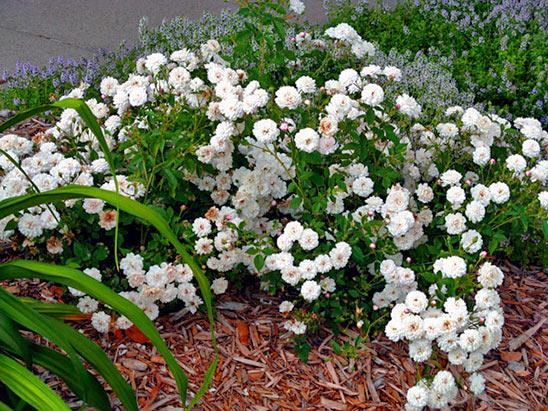
The Fairy looks good in group plantings, on slides, perfect for a trunk. Easily tolerates summer heat. Quite tall (50-80 cm) bush is covered with very decorative small and shiny leaves; small (3 cm in diameter) pale pink buds are collected in large clusters. Flowering lasts from mid-June to late autumn.
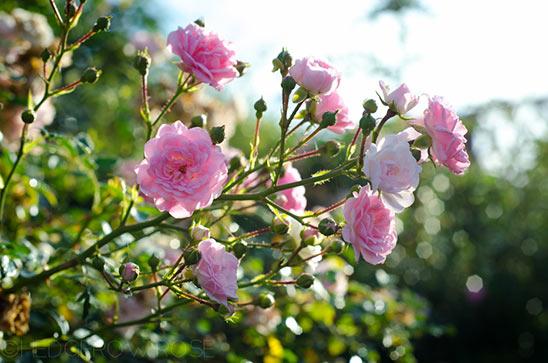
Rumba (Rumba) reaches a height of 90 cm. In width it can reach a larger size than in height. The color is rather unusual and beautiful - a combination of yellow, orange and red. Has a light aroma.

If polyanthus roses have piqued your interest, then we offer you an article where we share the secrets of growing them. After all, this class of roses also has its own peculiarities of planting and care.
We continue our acquaintance with the prima donnas of the pink kingdom. Today 10 of the most luxurious, in my opinion, polyanthus beauties of the world assortment will parade in front of you.
Polyanthus roses are truly luxurious
Their advantages are countless, see for yourself!


